Ever wish you could get your tweets, news headlines, project analytics, RSS feeds, and task tracking all in one place? Now you can with connectors for Microsoft 365 Groups.
Connectors are online apps, tools, and services, such as Twitter, Trello, or RSS, that you probably use every day to connect and collaborate, stay on top of current events, track projects, and so on. They're integrated with Microsoft 365 Groups and take just minutes to hook up.
Connectors fall into a variety of categories to suit every type of user and team, from the information worker focused on interests (Bing News, RSS) or productivity (Trello, Asana) to developer automation tools, (BuildKite), to email marketing services (MailChimp), and so on. You can hook multiple connectors to a group, and when you hook up one or more connectors, they're available to everyone in the group. No additional steps required!
The list of connectors is always changing as new services and tools are added. Here's a snapshot of some of the connectors that are available for your use today.
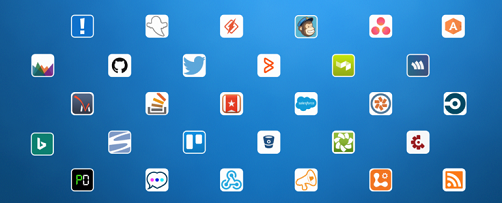
How connectors work
When you connect a tool or service to a group, everyone in the group can see the messages delivered by that service. For example, let's say your group wants to follow news reports about your company's new product that's hitting the market. You could add the Bing News connector to your group, configure it to send you links to topics of interest, and specify the frequency of delivery. When news headlines are sent to your group, everyone in the group will be able to read and respond to them.
The messages are delivered as rich connector cards, which can be viewed in multiple clients including Outlook on the web and Outlook for Windows. Here's an example of what the Yammer connector card would look like:
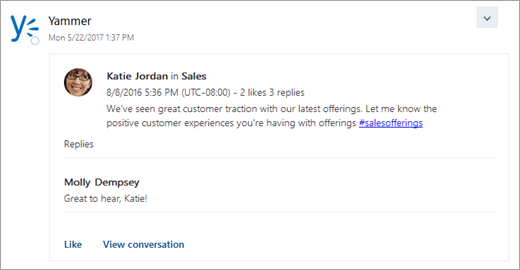
Actionable messages
The information from your connected services is delivered on rich connector cards. Some cards (Trello, Asana, GitHub, BitBucket, Twitter, and Wunderlist) include action buttons, such as Like, Comment, or Due Date, which allow you to take quick actions from Outlook rather than switching to other apps or logging in to other services. Here's an example of a card with action buttons:
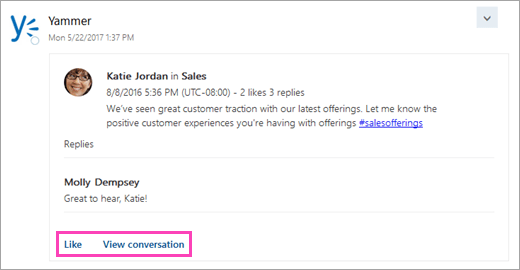
Note: To see action buttons in Outlook for Windows, you need to follow the group. See Follow a group in Outlook for more information.
These actionable messages are also available in connectors for your Outlook inbox.
Add or remove a connector
You must be using Outlook on the web to add or remove connectors. Any group member can add a connector to a group; any group member can remove it, too. The person who adds the connector is the only one who can modify its settings, such as changing the frequency of delivery.
To add a connector
-
Open Outlook on the web.
-
In the navigation pane, under Groups, select your group.
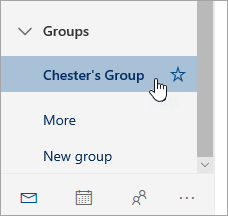
-
At the top of the page, select
 > Connectors.
> Connectors. -
Browse the list of connectors. When you find the one you want, select Add.
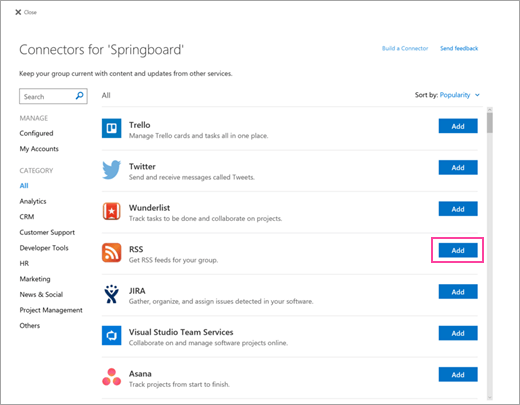
-
Follow the instructions on the screen to set up the connector. (Not all connectors are integrated in the same way. Some can be configured entirely from within the Microsoft 365 Groups user interface, while others require some set up on the service provider's site. Each connector includes set-up instructions to walk you through the process.)
To remove a connector
-
Open Outlook on the web.
-
In the navigation pane, under Groups, select your group.

-
At the top of the page, select
 > Connectors.
> Connectors. -
Select Configured.
-
Under the connector you want to remove, select Configured (the number on the button indicates how many instances of this connector are configured for your group).
-
Locate the specific instance of the connector to be removed and select Manage.
-
Select Remove.
Manage your connected accounts
Most connectors require a user account in order to hook them up. Once hooked up, they're known as connected accounts and are listed on the My Accounts page. The My Accounts page enables you to manage all of your connected accounts from one location. The My Accounts page is only available in Outlook on the web.
Note: The username or password for the connected account are not stored in Microsoft 365.
To view and remove connected accounts
-
Open Outlook on the web.
-
In the navigation pane, under Groups, select your group.

-
At the top of the page, select
 > Connectors.
> Connectors. -
Select My Accounts.
-
Browse the list of connected accounts. If you want to remove the account, select Remove.
Note that the connected account will be removed from all the groups where it is used.
Frequently asked questions
-
Can I disable connectors?
Admins can use Exchange Online PowerShell to disable connectors for an entire tenant or for a specific group mailbox. All users in that tenant or mailbox would be affected. It's not possible to disable for some and not others. The tenant-level setting overrides the group level setting. For example, if an admin enables connectors for the group and disables them on the tenant, connectors for the group will be disabled.
To learn how to connect to Exchange Online PowerShell, see Connect to Exchange Online PowerShell.
-
To disable connectors for the tenant, run the following command in Exchange Online PowerShell:
Set-OrganizationConfig -ConnectorsEnabled:$false
-
To disable connectors for a group mailbox, run the following command in Exchange Online PowerShell:
Set-UnifiedGroup -Identity contosogroup@contoso.com -ConnectorsEnabled:$false
-
To disable actionable messages for connectors for the tenant, run the following command in Exchange Online PowerShell:
Set-OrganizationConfig -ConnectorsActionableMessagesEnabled:$false
-
-
How can I add a new connector to the list?
Follow these instructions to add your connector to the list.
Related Topics
Connect apps to your inbox in Outlook on the web
Learn about Microsoft 365 Groups
Subscribe to an RSS feed
Learn about Outlook.com groups
No comments:
Post a Comment